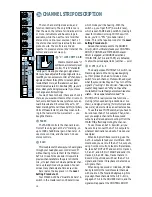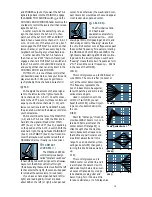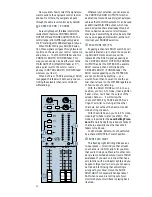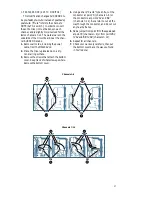
13
SERIAL NUMBER
MANUFACTURING DATE
ING.
FUSE
UTILISE UN FUSIBLE DE RECHANGE DE MÊME TYPE.
DEBRANCHER AVANT DE REMPLACER LE FUSIBLE
WARNING:
TO REDUCE THE RISK OF FIRE OR ELECTRIC SHOCK, DO NOT
EXPOSE THIS EQUIPMENT TO RAIN OR MOISTURE. DO NOT REMOVE COVER.
NO USER SERVICEABLE PARTS INSIDE. REFER SERVICING TO QUALIFIED PERSONNEL.
4
5
6
3
2
1
CHANNEL INSERTS
PRE-FADER / PRE EQ TIP SEND / RING RETURN
(
)
D BY MACKIE DESIGNS INC.
PATENT PENDING
MADE IN USA
WOODINVILLE WASHINGTON
INSERT (Channels 1–6)
These jacks, on the back of the MicroSeries
1402-VLZ, are where you connect serial effects
such as compressors, equalizers, de-essers, or
filters . Since most people don’t have more
than a few of these gadgets, we’ve included in-
serts for just the first six channels. If you want
to use this kind of processing on Channels
7–14, simply patch through the processor
before you plug into the MS1402-VLZ.
The
INSERT
points are after the
TRIM
and
LOW CUT
controls, but before the channel’s
EQ
and
FADER
controls. The
send
(tip) is
low-impedance (120 ohms), capable of
driving any device. The
return
(ring) is high-
impedance (over 2.5k ohms) and can be
driven by almost any device.
INSERT
cables must be wired thusly:
“tip”
this plug connects to one of the
mixer’s Channel Insert jacks.
“ring”
tip
ring
sleeve
SEND to processor
RETURN from processor
(TRS plug)
Tip = Send (output to effects device)
Ring = Return (input from effects device)
Sleeve = Common ground (connect shield to
all three sleeves)
Besides being used for inserting external
devices, these jacks can also be used as chan-
nel
direct outputs
; post-
TRIM
, post-
LOW CUT
,
and pre
EQ
. Check out the 4-track hookup dia-
gram . Here’s three ways you can use the
INSERT
jacks:
Direct out with no signal interruption to master.
Insert only to first “click.”
Channel Insert jack
Channel Insert jack
Channel Insert jack
Direct out with signal interruption to master.
Insert all the way in to the second “click.”
For use as an effects loop.
(TIP = SEND to effect, RING = RETURN from effect)
MONO PLUG
MONO PLUG
STEREO
PLUG
AUX RETURNS
This is where you connect the outputs of
your parallel effects devices (or extra audio
sources). These balanced inputs are similar to
the stereo line inputs without EQ, Aux
Sends, Pan, Mute, and Solo. The circuits will
handle stereo or mono, balanced or unbal-
anced signals, either instrument level, –10dBV
or +4dBu. They can be used with just about
any pro or semi-pro effects device on the mar-
ket.
To learn how signals are routed from
these inputs, see
.
One Device: If you have
just one parallel effects
device, use
AUX RETURN
1
and leave
AUX
RETURN 2
unplugged.
That way, the unused
AUX RETURN 2
LEVEL
control can be used to feed
AUX
RETURN 1
to your stage monitors, via
the
EFX TO MONITOR
switch
.
Mono Device: If you have an effects de-
vice with a mono output (1 cord), plug that
into
AUX RETURN 1 LEFT
and leave
AUX
RETURN 1 RIGHT
unplugged. That way the
signal will be sent to both sides, magically
appearing in the center as a mono signal.
This won’t work with
AUX RETURN 2
—
you’ll need a Y-cord to feed the L/R bus. In
short,
AUX RETURN 1
uses jack normalling.
AUX RETURN 2
does not use jack normalling.














































